There are over 100 different recognized types of cucumbers and hybrids of cucumbers. They belong to the Cucurbitaceae family which also houses squash, melons, and gourds. Cucumbers are related to pumpkins, watermelons, summer squash such as zucchini, and winter squash like butternut.
If you’re growing any of these plants in your garden, they can cross pollinate. You won’t get any cucumber/pumpkin hybrids during that growing season, but if you plant seeds the next year, you could end up with “cuckins,” “buttercumbers,” or some other strange amalgamation.
Cucumbers are full of vitamins and minerals such as Vitamin K, Vitamin C, Magnesium, manganese, and potassium. They are very low in calories and contain a lot of water which makes them an excellent snack on hot days. Cucumbers are up to 96% water. When possible, wash and consume the peel too, this contains a lot of the fiber and nutrition content.
We aren’t going to cover every single variety of cucumber, but we will touch on 21 of the most popular types. Here we will go over what they look like, how to tell when they are ripe, and what you can expect when you bite into them.
Table of Contents
Types Of Cucumbers
1. Armenian Cucumbers
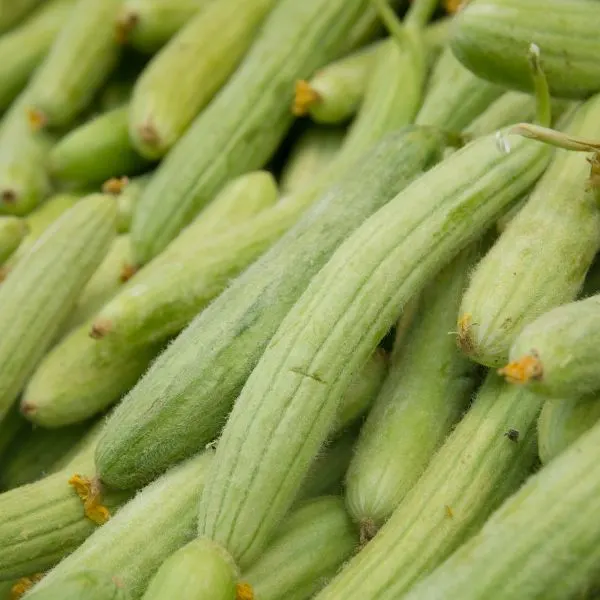
Armenian cucumbers are also known as “yard long” cucumbers, snake cucumbers, or snakemelons. They aren’t true cucumbers, but actually a type of muskmelon, but they have the elongated shape you come to associate with cucumbers.
These cucumbers have a thin, light colored, ribbed skin, and may have yellow or dark green stripes. Try to pick them when they are about 11 to 15 inches long. If you are growing them in your garden, this will take anywhere from 55 to 75 days. If you leave them on the vine longer, they will continue to grow and end up tough and full of large seeds.
Armenian cucumbers can be eaten just like typical store bought cucumbers. Slice and eat them as they are, put them on salads, or use them in your favorite dip recipe. They have a mild, sweet flavor and can also be grilled with kabobs, or pureed in your favorite smoothie.
2. American Slicing Cucumbers
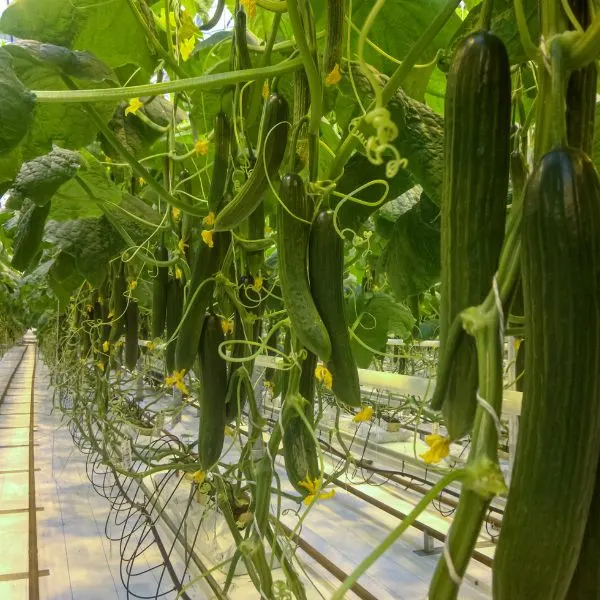
These cucumbers are mostly what you see in chain supermarkets. They tend to be dark green with some lighter coloration or yellow patches. American slicing cucumbers are grown to have soft, edible seeds, and a thin, edible skin.
If they are left on the vine to ripen, they can turn yellow, become woody, and take on a sour or bitter flavor, so they are picked when still green and unripe. Pick American slicing cucumbers when they are still green and about 8 to 10 inches long.
These cucumbers are best sliced and eaten raw, with a dip, put on sandwiches, or in salads. They don’t do well in pickling or cooking because they can end up mushy.
Most consumers peel them before eating because they get treated with a thick waxy coating to prevent spoilage during transit. Unfortunately, as your mother or grandmother told you, peeling them does remove most of the nutrients. To get the waxy coating off you can wash them with a fruit wash, or make your own.
Mix an equal solution of vinegar and water in a bowl then add a tablespoon of baking soda. Wait for the bubbling to stop, then use a soft vegetable or similar bristled brush to wash the wax off and then you can consume the whole cucumber!
3. English Cucumbers
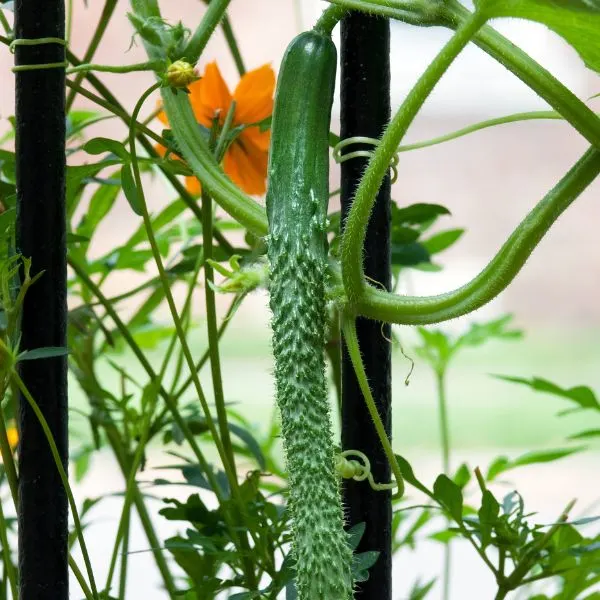
Also known as European or hothouse cucumbers, these are another popular cuke found in your local grocery store. You’ll see these wrapped in plastic and are traditionally more expensive.
They are called hothouse cucumbers because they are typically grown in a greenhouse, or “hothouse.” This leads to the higher prices, but they are typically twice as long as traditional cucumbers.
They are thin, usually uniformly green, and have ridges that run the length of the veggie. They have very thin, edible skin that is easily nicked, which is why they are always wrapped in plastic.
Inspect them before you buy them, the plastic doesn’t allow the cucumber to “breathe” and they can get very mushy, especially at the ends if they are not fresh. You’re looking for firm flesh, if it’s soft or discolored, pick another one.
Hothouse cucumbers are seedless or have very small, unnoticeable seeds, and a milder flavor than traditional cukes. These cucumbers are best eaten raw, in salads, or sliced and served as hors d’oeuvres.
4. Kirby Cucumbers
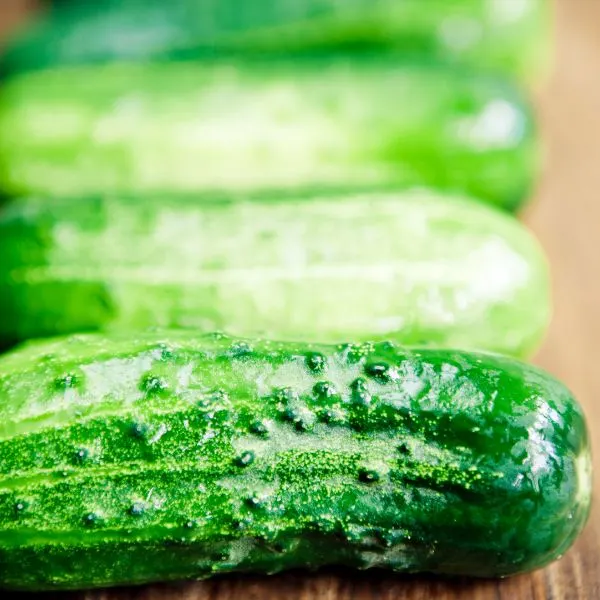
In the 1920s Kirby cucumbers were developed by Norval E. Kirby, but in about a decade, these unique cucumbers were overtaken by the National Pickling Cucumber. Now, nearly all pickling cucumbers are also termed Kirbys, though they are not true.
Whatever their name, these cucumbers are typically used for pickling because they are only 3 to 6 inches in length, are unwaxed, and are firm and crisp. While they are an excellent pickling cucumber, Kirbys can be eaten raw. They have a refreshing, mild flavor and a sharp snapping crunch.
These cucumbers are usually bumpy, a little irregular looking, and can be light to dark green with yellow speckling or patches. They may also have black or white spots on the bumps.
Whenever you are looking for something with a good mouth feel and a satisfying crunch, add in some Kirby cucumbers. You can slice them raw for some added crunch in your salads, or dice them up and put them into a gazpacho. They also lend well to many Korean dishes and kim-chee.
If you’re growing these little picklers at home, pick them when they are about 3 to 5 inches long, or if you’re watching them grow, leave them on the vine no longer than 8 to 10 days after pollination.
5. Lemon Cucumbers
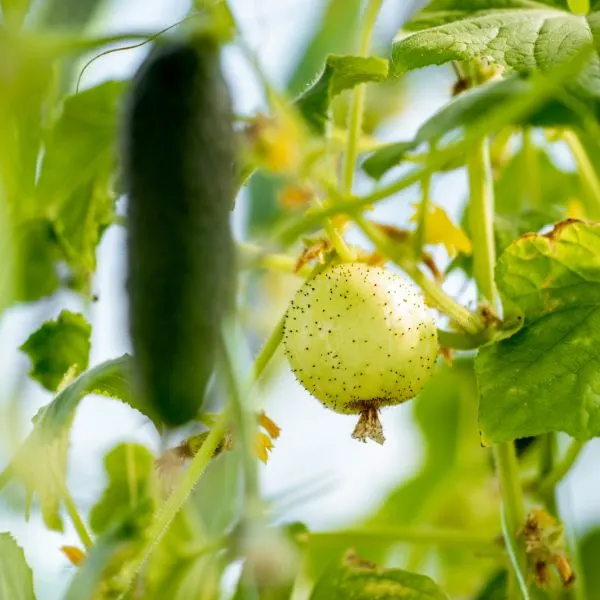
Lemon cucumbers are named more for their look than for the tart flavor of the citrus fruit. These cucumbers are small, round, and yellow as the name suggests. They have marbled, yellowish skin that can be eaten.
These round cukes have a mild flavor with a nice crunch. They are great eaten raw, in salads, pickled, and cooked in many recipes. They are also a favorite for hot summer day adult beverages such as a lemon cucumber cocktail.
For any recipe that calls for cucumber, you can substitute a lemon cucumber in its place because of its amazing versatility. The insides can be scooped out to make small, handy bowls for dips, salsas, or for cool soups such as gazpacho.
These little cukes are easy to grow in the home garden and they grow quickly. Pluck them off the vine when they are about the size of a tennis ball. They are usually ready around 60 days after planting.
6. Gherkins
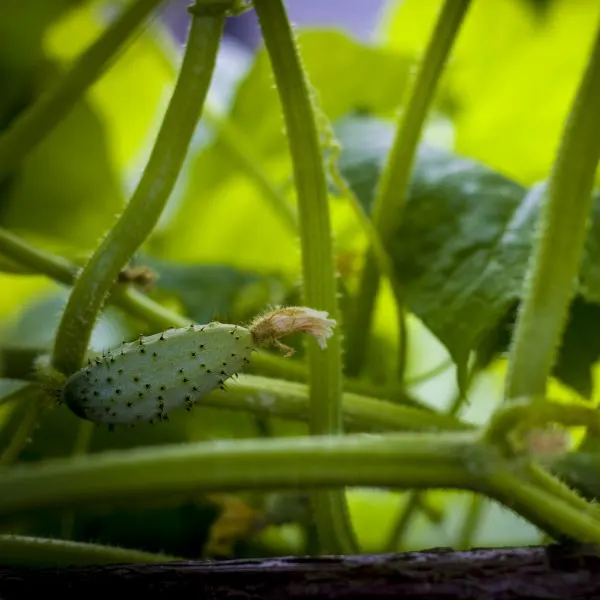
Gherkins are essentially baby cucumbers that are typically pickled. Because of their crisp texture, these cucumbers are also great for cooking. They can be sauteed or added to stir fries. Gherkins are also great for relish trays, eaten raw, or served with a bloody mary.
Gherkins are only about 2 to 3 inches long, have plenty of small bumps on the outside, and have tiny seeds inside. They tend to be curved and mostly green.
In the home garden, gherkin cucumbers are usually ready to be picked after 40 days. Just pluck them off the vine when they grow to about 2 to 3 inches long.
A sharp snap, pleasant crunch, and may be slightly bitter, or contain a stronger cucumber flavor. Cooking and pickling them takes away any bitterness.
7. Amiga Cucumbers
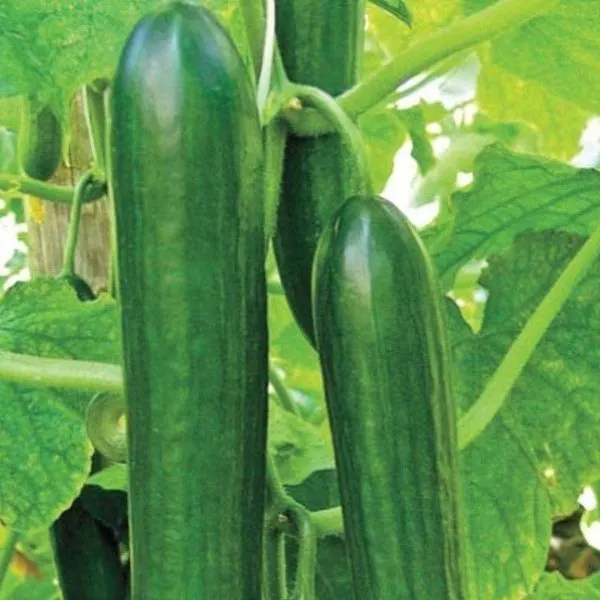
Popular in many Mediterranean dishes, amiga cucumbers are ridged cucumbers that grow about to 6 inches long. They are a solid green, have ridges, and have no spikes.
These cucumbers are a sweet tasting cucumber that works well in salads and pairs well with fish and other light dishes. They can also be eaten raw with the skin on, so slice some up and snack on amiga cucumbers this summer.
Unlike some cucumber varieties, these have a long shelf life, though once you taste them, they won’t last long in your household.
If you are growing these at home, be sure to sow them in soil that is consistently warmer than 50 degrees Fahrenheit, because they won’t germinate in cool soil. Pick them when they get around 6 inches long, which will typically happen after around 50 days after planting.
8. Diva Cucumbers
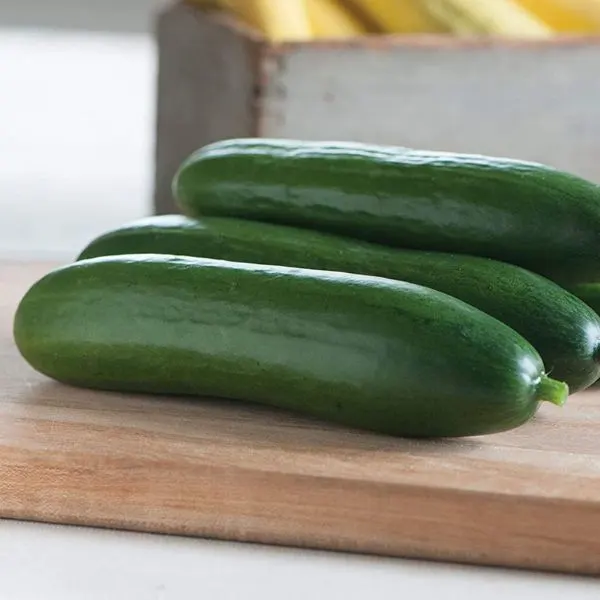
Diva cucumbers are usually harvested when they reach 5 to 7 inches long but can grow as long as 18 inches. They are a variety of English cucumbers and share many of their characteristics.
Divas have a soft, smooth, glossy skin that is edible and packed with nutrition. They are as beautiful as they are tasty with their forest green glossy exterior. The flesh is crisp, and they have very few if any seeds which make them great for slicing and snacking or dipping.
You’ll love the sweet, flavorful cucumber flavor that supermarket varieties are typically missing. When you taste these cucumbers, you may not ever purchase another type again.
When growing these in the garden you’ll find that they are prolific plants and don’t need a pollinator. These cucumbers are typically ready around 50 to 60 days after germination.
9. Chinese Soyu Cucumbers
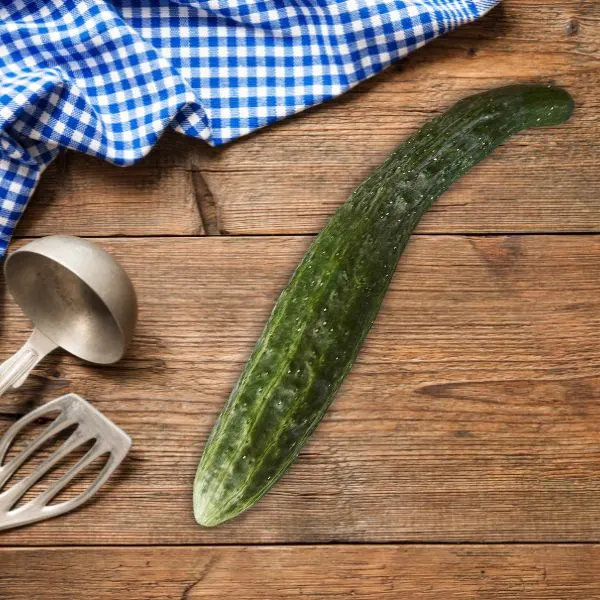
A long, striped variety of cucumber, these often grow longer than 15 inches and can be straight or as curved as coil spring. They have alternating stripes of dark and light green. They are a “burpless” variety, meaning they produce much less gas than other varieties, and they tend to have few if any seeds.
Chinese Soyu cucumbers have a crisp, pale colored flesh with a mild and sweet flavor. They are great sliced and eaten with the peel on, added to salads, or pickled. Another way to prepare these wonderful cucumbers is to stir fry them with garlic, Chinese five spice, and other herbs and spices.
In the home garden, supporting the vines on a trellis grows straighter cucumbers, but if you like the curly-q look, let them grow on the ground. You’ll just have to watch out for pests and powdery mildew. These cucumbers are typically ready after 55 to 65 days.
10. Korean Cucumbers
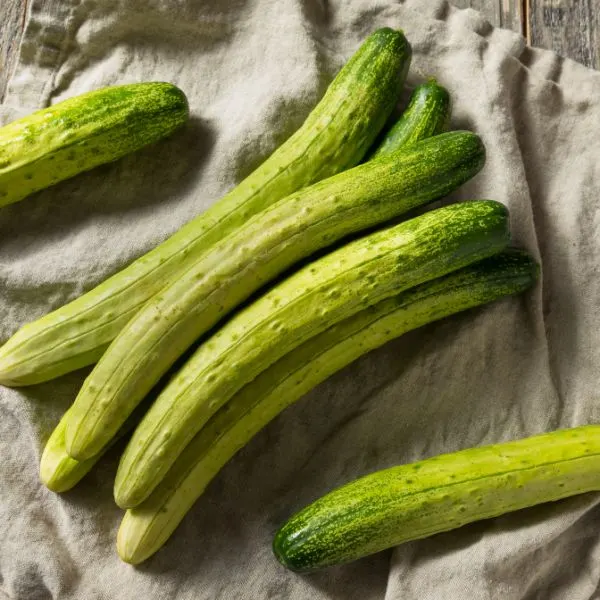
Korean cucumbers are best eaten raw or marinated in oils, vinegars, and spices. They have a crunchy sweet taste and forego the bitterness of some other varieties. These cucumbers are long and slender, have thin skin, and range in color from light green, and whitish, to dark green.
Inside, the flesh is creamy looking with small, soft seeds in the middle. Sometimes they have a few spines, but the skin is thin and easily edible. Korean cucumbers usually grow up to 18 inches long.
Korean cucumbers don’t cook well, so they are best in cucumber salads, as a salad additive, in sandwiches, or in other raw applications. Often these cucumbers are used in kim-chee or sliced, scooped out, and stuffed with other vegetables or meat mixtures.
When growing these at home, they tend to be ready for harvest at 55 to 75 days after germination. Some varieties have been formulated to be ready at about half that time though.
11. Iznik Cucumbers
Iznik cucumbers are typically small, plump, dark green, and smooth skinned. They are usually harvested when they reach only 3 to 4 inches long, but even when they grow larger, they remain succulent and delicious.
Izniks are smooth, spineless, and seedless. These cucumbers are excellent raw, as well as pickled. They have a smooth, sweet, melon-like flavor with zero bitterness. These are a great all-purpose type of cucumber.
When growing them in the garden, they are compact plants that do well in pots and on patios. You don’t have to worry about planting several of these plants as they are prolific growers.
12. Katrina Cucumbers
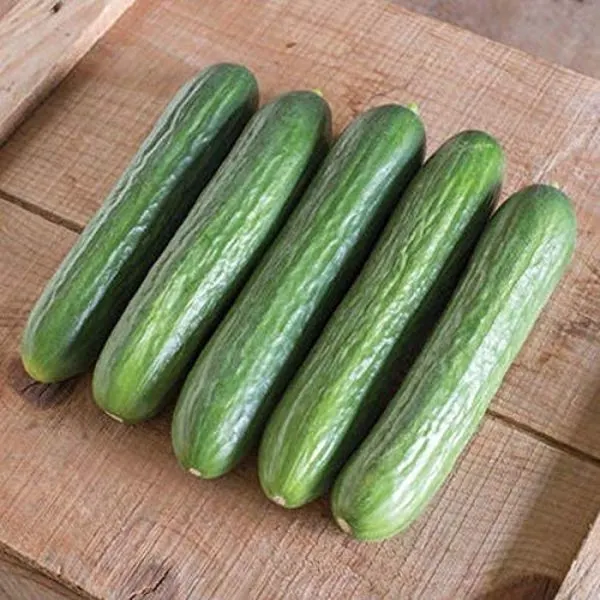
Katrina cucumbers are another seedless and burpless variety. They are harvested at around 6 inches long. These tasty cucumbers are excellent snacking varieties, with their spineless, smooth, ridged skin, they are great sliced and eaten or added to your favorite salad recipe.
While they are best eaten raw and not cooked, they can also make some excellent pickles when you add them to your favorite pickle brine.
Growing them at home will produce a high yield, especially if you can grow them in a greenhouse. These cultivars are disease resistant and grow quickly so you’ll have a lot of them in short order. They’ll even continue to produce until frost finishes them off for the season.
13. Persian Cucumbers

If you see Persian cucumbers in the store, you should go ahead and snatch them up. Pass by all the other varieties and take these beauties home. When you get in the door, slice them up and sprinkle a tiny amount of sea salt on them and enjoy. You can thank me later.
Persian cucumbers come from Iran—what was once Persia—and can be available year round. They are only about 5 to 6 inches long and are somewhat narrow. They are mostly seedless, very crunchy, not watery, and have a sweet, mild flavor that’s really making them more popular.
The thin skin is smooth with slight ridges, and uniformly green. They are great in various salads, raw, with feta cheese, or in a fruit salad for extra crunch. Persian cucumbers are also the perfect companion to cold soups and cocktails.
You can add these to stir fries or pickle them as well, so go ahead and get some of these versatile veggies. If you can grow them at home, be sure to pick them when they get about 4 to 6 inches long. If they are allowed to sit on the vine much longer than that, they tend to lose their sweetness and turn bitter.
14. Japanese Cucumbers
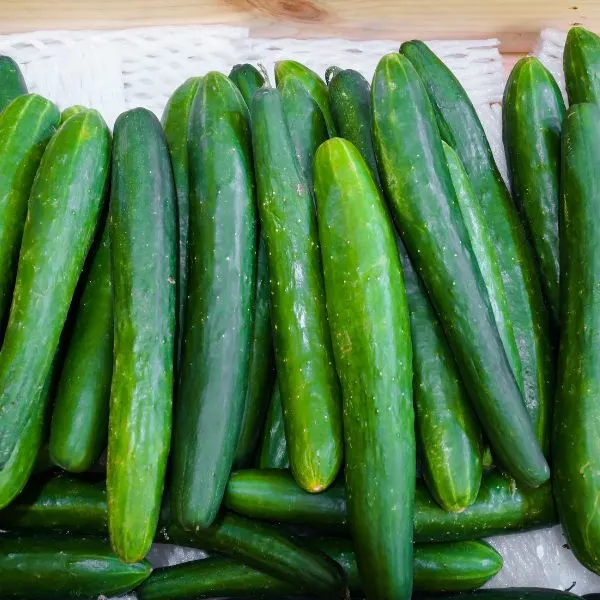
Also called Kyuri cucumbers, these long, slender cucumbers look like a hybrid between European and American cucumbers. They are thin and long with slight ridges like European cucumbers, but they have the dark, glossy color, and spines associated with American varieties.
They have a taste that is similar to an unsweet melon and have no hint of bitterness. In Japan, they are often consumed during the hot summers or sliced delicately with some sushi rolls.
You can use these in place of any other type of cucumber dish. Eat them raw, put them in your salads, cook them in stir fries or other recipes, or pickle them for a briny, sweet, or sour treat.
In the home garden, plant them when the temperatures are nice and warm and there’s no threat of frost. Harvest them when they reach at least 6 inches in length, though you may want to leave them a little longer and allow them to grow a little longer.
15. Poniente Cucumbers
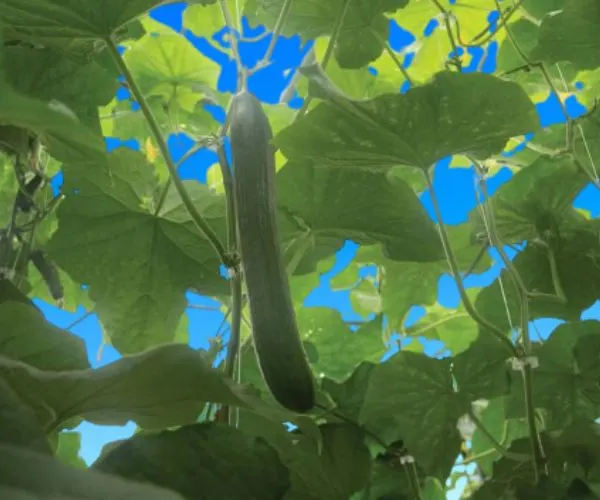
Poniente cucumbers are a European variety of cucumber that sports glossy green, ribbed skin. They are 12 to 14 inches long, slender, and have a sweet, delicate flavor, without any trace of bitterness.
These sweet cucumbers are best eaten raw or in salads. They don’t cook well and can end up mushy and falling apart when they are exposed to high heat. Don’t let that deter you from marinating them in balsamic vinegar, or herbed olive oil.
Growing these in the home garden is possible if you wait until the soil is at least 70 degrees Fahrenheit. Mulch on the ground to help keep the roots warm is a great way to keep these plants happy. Harvest them when they reach about a foot in length.
16. Salt And Pepper Cucumbers
As the name suggests, these cucumbers have black spines on pale yellow or white skins. They are squat, rounded, and about 2 to 4 inches long. The inner flesh is pale, with central, translucent seeds.
These cucumbers are best for eating raw and pickling. Prepare salt and pepper cucumbers in salads, cold pasta dishes, or in hor d’ oeuvres. They are also great as pickles and are an award winning white pickle variety.
The reason for the award is that the salt and pepper cucumber plant is the first white cucumber specifically used for pickling to resist powdery mildew.
Salt and pepper cucumbers have a nice crunch to them with a mild cucumber taste. They are excellent with herbs like dill, mint, and oregano, or do as the name suggests, sprinkle some salt and pepper on them and enjoy.
When growing these pale colored cucumbers, pick them when the skin is light yellow, and they are about 4 to 5 inches long. You can store these for up to a month in the refrigerator, but why would you take that long to consume these beauties?
17. Socrates Cucumbers
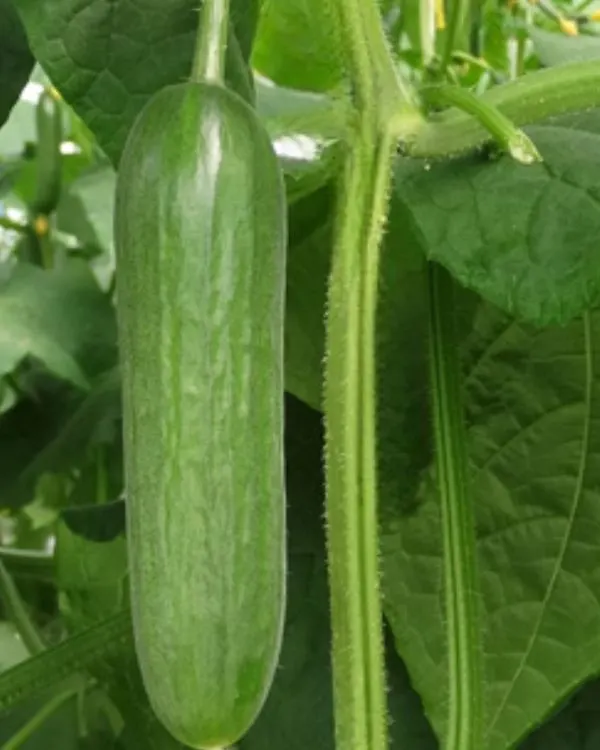
If you’re looking for a new favorite cucumber as far as flavor, give the Socrates cucumber a try. These cukes are dark green, have thin, edible skins, and are nearly seedless. Another benefit of seedless varieties is they are usually “burpless.
This variety of cucumbers grows to be 5 to 8 inches long. They are excellent for slicing and eating, putting on salads, making cucumber salad, making sandwiches, or adding to other cool dishes for summer fare.
In the home garden, these plants produce a ton of cucumbers. For a family of four that regularly consumes cucumbers, you may only need a single plant. If you are looking to pickle or preserve a bunch, then go ahead and get a few plants.
You’ll soon have plenty of pickle jars full of these tasty treats to eat all year long. They like it warm and do well in greenhouses. You can also mulch the ground to help keep them warm and growing well.
18. Tyria Cucumbers
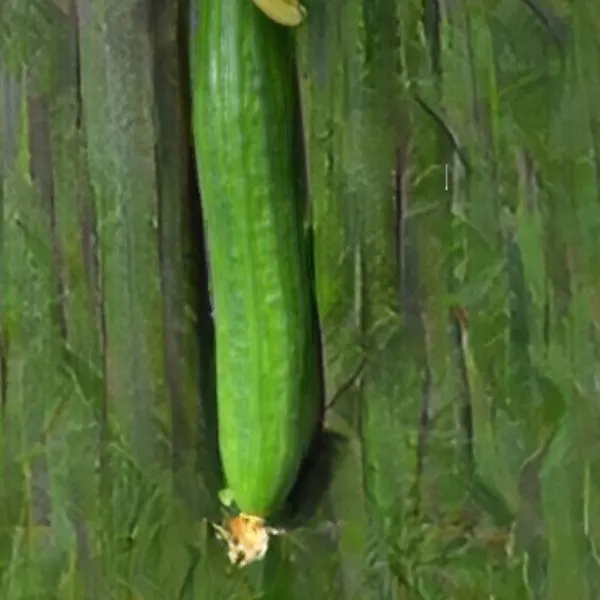
Tyria cucumbers are long—averaging around 14 inches—heavily ridged, dark green cucumbers. They have a thin skin that can be eaten instead of peeled off. The flavor is mild, sweet, and not bitter, with a nice crispy crunch.
These cucumbers are similar to European varieties but with a slightly sweeter flavor. They are best sliced and eaten, made into salads, or as a salad topper.
When growing these at home, put them on a trellis to keep them straighter. Harvest them once they reach about a foot or slightly longer.
19. Unistar Cucumbers
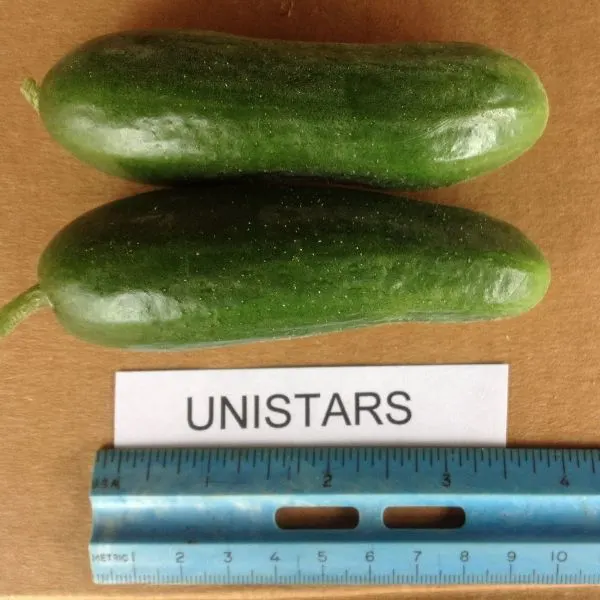
Sometimes unistars are considered cocktail cucumbers because they are harvested when they are so small. They tend to be picked when they are only about 4 inches long. They have a dark green, somewhat glossy skin.
These cucumbers are crunchy, have a cool, sweet, cucumber flavor, and are excellent eaten straight off the vine (well, maybe after you wash them first). These juicy cucumbers are best consumed raw with salads, on their own, in cucumber sandwiches, or in other unheated dishes. Unistars are another excellent pickling cucumber because of their firm flesh and small size.
Growing these cucumbers is a treat. They are very disease resistant, do much better with a bed of mulch, and love plenty of light and warmth. By treating them right, they will reward you with an abundant harvest. Be sure to pick them frequently, because if fruits are left on the vine, production will decrease.
20. Watermelon Gherkin Cucumbers
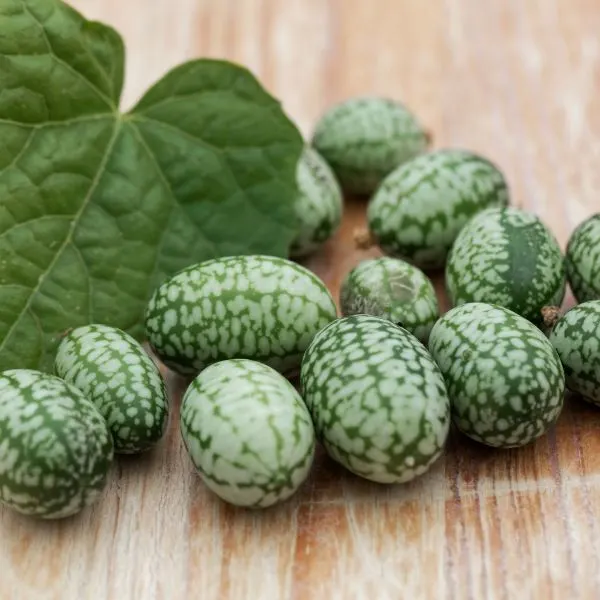
These cucumbers seem to have an identity crisis. Are they cucumbers, gherkins, or watermelons? Survey says—they are a little of all three!
The watermelon gherkin cucumber is small like a gherkin—only growing to about an inch or two long. It is shaped like a watermelon, only much smaller, and looks similar to the summertime treat with its alternating dark and light green striations. When you slice it open you’ll see that it looks like a cucumber—light green flesh with centralized translucent seeds.
The taste is like no other cucumber on our list so far. They have a citrus-like tanginess with a sharp crisp bite to them. It’s like eating a cucumber that’s been marinated in citrus juice.
These confused cucumbers are exceptionally high in Vitamins A and K and can be eaten whole, skin, seeds, and all. These characteristics have helped to increase their popularity, especially in the home garden and restaurants. They are prolific producers and are fun and easy to pop right into your mouth.
The watermelon gherkin cucumber is great eaten alone, pickled, used in cocktails, or in recipes, so it’s quite versatile. Juice them and make a new cocktail, add them to salsa for a unique flavor, or saute them with olive oil and your favorite seasonings.
21. West Indian Gherkin Cucumbers

If you never saw these before and come across them at the local grocer, you’d probably give them a strange look before you hurried your cart away. They are small, similar in size to the watermelon gherkin, only they are covered in spikes or spines.
They truly look inedible with the prolific hairs or spines all over them, but you’d be missing out on a great experience. They are also called the prickly cucumber, but they are perfectly safe to eat raw.
West Indian Gherkin Cucumbers are crunchy, with a pronounced flavor, with a hint of sourness. These little prickly cucumbers can be eaten raw, pickled, or cooked for a unique treat.
These gherkins are great in relishes and pair well with most meats such as chicken, ham, and beef. Make a stir fry with your favorite meat (or go vegetarian) add some cabbage, carrots, onions, bell peppers, mushrooms, and garlic for a dinner your family will be asking for again and again.
Both these and the watermelon gherkin cucumber grow great on a trellis and will reward you with a massive harvest of tiny delicious fruits.
FAQs
What is the sweetest tasting cucumber?
The striped Armenian cucumber is considered by many to be the sweetest type of cucumber. They are actually considered a species of melon if that gives you any hint of their sweetness. Striped Armenian cucumbers are narrow, long, green striped, have a thin skin and have small edible seeds.
What is the most compact cucumber plant?
Spacemaster cucumber plants are probably the most compact at a small 18 to 38 inches in height. These little plants are great for planting in pots and leaving on a porch or patio. Don’t let the size fool you though because they still can grow cucumbers a full 7 to 8 inches long.
If you want smaller cucumbers, just harvest them when they’re still small. Snatch them off the vine at 4 inches and eat them as they are or pickle them. Even though these plants are relatively small, they are still quite prolific.
Is it safe to eat cucumber seeds?
Cucumber seeds are not only safe to eat, but they come with plenty of health benefits. Cucumber seeds contain a ton of antioxidants, provide you with a lot of fiber, and may even help improve cholesterol. Go ahead and consume the entire cucumber, and why not go for the seeded varieties instead of the seedless ones? They’re good for you!
Should you eat the skin on a cucumber?
All cucumber peels are edible, and most of them contain plenty of extra fiber, Vitamins A, K, and potassium. Some cucumber varieties have thicker skins than others, so if the skin is too thick for you, go for a different variety.
Be sure to wash the cucumber first, some cukes are coated with a waterproof wax that isn’t very palatable and can contain a lot of pesticides. Use a mixture of vinegar, water, and baking soda to remove the wax.
That Wraps It Up!
When you’re shopping for cucumbers, keep your eyes peeled for different varieties, and don’t be afraid to try them out. You may find you like some “exotic” varieties much better. It all depends on what kind you are looking for.
Most cucumbers are excellent sliced up and eaten raw, while a few such as Armenian, lemon, Chinese, or West Indian gherkins can be cooked in many recipes for an added flair to your nightly dinners.
If you love pickles (like I do) try your hand at pickling some of these varieties like the watermelon gherkin, lemon, unistar, Socrates, or Korean cucumbers. There’s really nothing like a pickle you crafted at home, especially if you’re growing your own food. Not only is it fun to try something new, but the taste can be worlds better than mass produced foods.
More plant stuff
